- This is the
story of Buddhist Master Atisha who travelled from Bengal to Sumatra in
Indonesia to meet his Guru and on return he headed to Tibet.
- It also has
Atisha’s teachings explained simply.
Reflections on the revered
Indo-Tibetan Buddhist master Atisha’s life, learnings and teachings after facilitating
a nine-week meditation program on his techniques of heart transformation,
inculcating Bodhicitta, the awakening mind.
There are many journeys. Some are made not
by men, but by destiny. Journeys not of any one person, but of all humans, for
all times to come. This story is about one such journey, that of a man surfing
the waves of the timeless: Atisha Dipankara Srijnana. A prince, a monk, a
master, a pilgrim of Life.
Go East
A thousand years ago, 1011 or 1012 CE.
Near the Bay of Bengal.
It must have been twilight. The darkness,
going but not yet gone. The light coming, but not yet come. The fleeting
meeting of the night and day, when the fresh breeze from the sea touches the
soul of man. That is perhaps when Dipankara would have first heard the whisper,
‘Go East!’
The big rivers and the small. Curving,
stretching and swaying their way to the Bay. They would have carried upon their
waves, a boat. With not just a man, but a prayer. A prayer to reach the other
shore. The path to which passed through a monastery across the seas, far away
in the golden island, Suvarṇadvipa.
In that monastery lived a master. A
teacher of teachers. A guru of gurus. Dharmakirti, the
fame of Dharma.
Atisha had to reach him. Somehow, anyhow.
For Dharmakirti held a secret key that had been born in India, but was now
flowering in the East. A dharma-key that had to be rediscovered, reinstated
within. Atisha knew. He had to journey East, towards that sun, now softly
rising.
The boat carried 125 people towards the
ancient shipping lane - later known as the Straits of Malacca. Merchants in search of precious gold. And Buddhist scholars and
students in search of, well, the priceless diamond: Bodhicitta, the awakening mind.

Exchanging
Cultural Luxuries
In the sea route between India and China,
the golden island of Sumatra, Suvarṇadvipa, was a centre of exchange for both
kinds of cultural luxuries - material and spiritual.
In the 7th century, about three hundred
years before Atisha, Yinjing - a monk of the Chinese Tang Dynasty - on his way
to India had spent many months in a Suvarṇadvipa monastery alongside thousands
of scholars and pilgrims from various Buddhist schools of Mahayana, Theravada
and Vajrayana. The stories and practises from the golden island had travelled
with him to Nalanda Mahavihara, the renowned centre of learning in Jambudwipa,
and back.
Later in the 9th century in Nalanda, King
Balaputradewa from the Sailendra Dynasty which ruled Suvarṇadvipa had
contributed to the construction of a monastery and a temple.
And now in the 10th century from Nalanda,
continuing the sutras of spiritual exchanges between Jambudvipa and Suvarṇadvipa,
journeyed the great Atisha Dipankara Srijnana.
Atisha: Many
masters, Many paths, One Goal
Born as prince Chandrabhaga of Sahor,
Bengal, who had renounced all royal comforts to study under many mahasiddha’s
from the many spiritual traditions of Jambudvipa. The tantric yogis Avadhutipa and Rahulaguptavajra, the scholar-monk Bodhibhadra, Vidyakokila,
Jitari. A lineage holder of a number of Yogini tantras, such as the Laghusaṃvara Tantra. One who had
attained profound realization of Hevajra
tantra, Kriya tantra and even Anuttara Yoga tantra. At the age of 29
years ordained into the Mahasaṃghika ordination linage by the great Silarakṣita. Then studying the extent of
Buddhist knowledge with one hundred fifty-seven spiritual teachers in
Jambudvipa.
This master practitioner, this spiritual
adept was now journeying across the seas to the golden island to learn that one
greatest teaching which had, once in seed form travelled from Jambudvipa and
was now blossoming, across the seas in Suvarṇadvipa.
Dharmakirti
Suvarnadvipa: Master of the Golden Island
The one through whose heart it blossomed
was Guru Dharmakirti also known as Serlingpa. Born into the linage of the Sailendras,
the Royal family of Panangkaran. The great wise man of 8th century Java who had
dared to build at the foot of the mountain of fire, Merapi - from Sanskrit meru,
mountain, api fire - the most active volcano of Java.
King Panangkaran had built the
incredible stupa of Borobudur and two temples - Candi
Kalasan and Candi Sari - these of Devi
Tara, the goddess who blessed and guided Atisha throughout his life. Even
on this thirteen-month dangerous sea journey from Jambudvipa, to reach the Guru
who’d teach him, that which needed to be learnt the most: love.
In Atisha’s words, “The little warm-heartedness that I possess is due to the kindness of my teacher Serlingpa. Because of this, my lineage has blessings.”
Serlingpa or Dharmakīrti held in his heart the experience of the seed teaching which was flowering in Suvarṇadvipa: the teaching of the lotus.
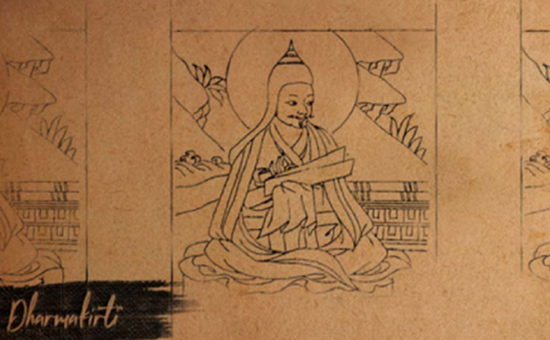
Pure Fame
Teachings: Vimalakirti
Just as a lotus does not grow in dry soil,
it needs murky waters, the mud, the same with bodhicitta, the awakening mind.
It needs the mud of passions, of desires, of self-grasping to flower. This
approach, says the celebrated 12th century commentary of Tibetan scholar Se
Chilbu, was akin to that of the non-Buddhist schools: without relinquishing
self-grasping (ego), use it as the very ground for training.
The scriptural authority Dharmakirti gathered this essence from was that one sutra which flavoured the flowering of Buddhism in East Asia. A sutra not given by Buddha, but a householder: Vimalakirti. A rich merchant of Licchavi clan who dwelled in Vaishali, Vajji Mahajanapada of ancient India at the same time as Shakyamuni Buddha.
The Vimalakirti Nirdes Sutra,
Teachings of Vimalakirti is believed to be a text of early Mahayana, estimated
around 100-200CE. Through lively episodes and humorous touches, it offers
teachings from unexpected locations ranging from a courtesan’s garden, to a
merchant’s home; via goddesses, via food, via household, via life in the world.
The sutras are radical not just for what
they say, but also for who teaches them, to whom. The teacher and the taught, reverse. A lay householder teaches Buddha’s ten major monk disciples. In the mud of the world, the learning. From within the murkiness, the clarity.
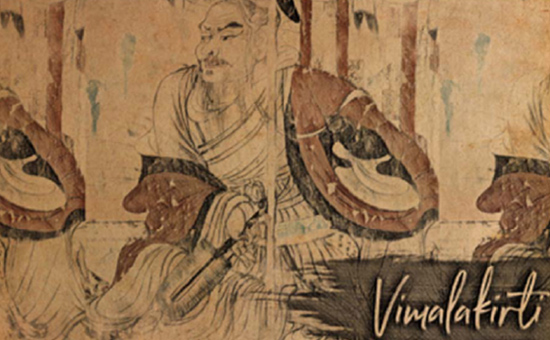
Weaving Asia: Silk Route and Beyond
Vimalakirti’s sutras caught the
imagination and the spirit of lands near and far, from China all the way to
Japan. They were translated several times in Chinese, the most popular translation
done in 406 CE, by Kumarajiva the Buddhist monk scholar from the ancient
kingdom of Kucha situated on the Northern branch of the Silk Road.
Translations in many other languages followed: Tibetan, Sogdian, Khotanese, Mongolian, and Manchu. Chinese art, literature was influenced deeply by them. Further east, in Japan the Vimalakirti sutras lay the foundation of Ch’an, or Zen.
These were the sutra teachings that had
flowered in Guru Dhramakirti’s heart. Their fragrance had reached Jambudvipa,
the land where Vimalakirti had first given these teachings. The Tibetan scholar
monk Se Chilbu states that Dhramakirti’s teachings were
based on the following statements of Vimalakirti:
“As seeds do not grow in the sky but do grow in the earth, so the Buddha-qualities do not grow in those determined for the absolute but do grow in those who conceive the spirit of enlightenment, after having produced a Sumeru-like mountain of egoistic views.”
“Just as a lotus does not grow out of a well-levelled soil but from the mire, in the same way the awakening mind is not born in the hearts of disciples in whom the moisture of attachment has dried up. It grows instead in the hearts of ordinary sentient beings who possess in full all the fetters of bondage."
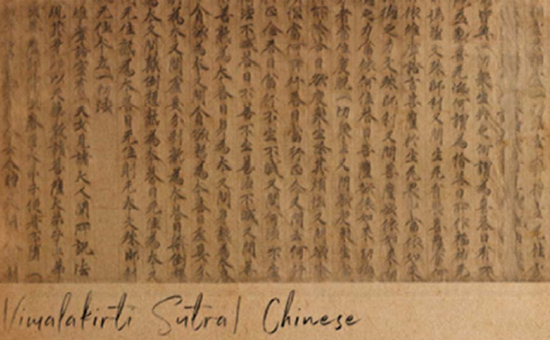
Bodhicitta: exchanging
self for others
The practice seemed simple. Yet it was the
most profound.
“Train in the two—giving and taking—alternately.”
The courage to absorb the darkness of
all beings. Their pain, sorrow, anger, hatred, misery. The courage to take
it all into your own heart. The darkest of the dark clouds. Of people you know,
people you don’t. Of people you love, people you hate. All people. All beings.
All their sins. All their ignorance. You take in.
In turn. You offer them love, light,
bliss. One breath at a time. Taking in, giving out. Not only for one
special person, not just for your own clan, your own people. Those too, but not
only.
In the practise Love meant an embrace of the
entire world, the entire universe. All sentient beings. This is how Atisha’s
guru Dharmakriti defined Love. A perfect antidote for the limited idea of self,
the ego.
The art of the practise lay in using the
breath: patience. The skill, in being able to deploy the mind: persistence. The
design in the ability to view all phenomena as dreamlike: clarity. The craft in
the ability to use all adversity as an opportunity: courage.
“When the world and its inhabitants boil with negativity, Transform adverse conditions into the path of enlightenment.”
Innovation & Disruption: mental rewiring
Radical creativity, disrupting the
destructive patterns of the mind. The wise one’s say, mind patterns not just
from this life, but lifetimes upon lifetimes. Formatting and retraining this
ancient mind. A creative step in the direction of realising one’s inherent
Buddha nature, call it awakened self, if you like.
This bodhicitta
creativity became foundational for Atisha as he journeyed back to Jambudvipa
and then, further.
Many moons later, one night. As Atisha slept in Vikramasila - a famous centre of Buddhist learning in India where Atisha was invited to teach upon his return - he heard the command of Goddess Tara to now, “Go North!”
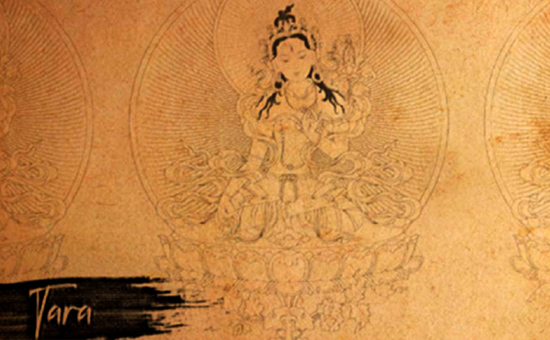
The Land of
Snows
The north meant The Land of Snows, Tibet.
The first human settlement happened there during the Mahabharata war. A military commander of the Kaurava army,
Rupati, left the battle, leading his soldiers North wards. Further and further.
Till they reached the Tibetan plateau. Thus, way before now, began the journey
linking India to Tibet.
So said the Tibetans who came to receive
Atisha, with sixteen ounces of gold and countless prayers.
“I am a Tibetan king here in the Land of Snows. Although we had former excellence, nowadays our merit has degenerated. Please have compassion for us. I constantly think of you, O Protector, as someone would think about water while in the plains of a desert.”
Atisha, resisted much. Even telling the
Tibetans that he had no compassion! But the people from the Land of Snows, oh
they were persistent. They braved all kinds of troubles to reach him, again and
again. They knew. Atisha was the master needed to refresh, to revive the river
of Dharma flowing in Tibet. Only and only Atisha could do that which needed to
be done. And they knew. He would come.
The Goddess of compassion, Tara, heard. It was on her command, we are told, Atisha started on the other historic journey up north. A journey made, not by man, but by destiny. A journey without which we would have nothing left of the story which has just been told.
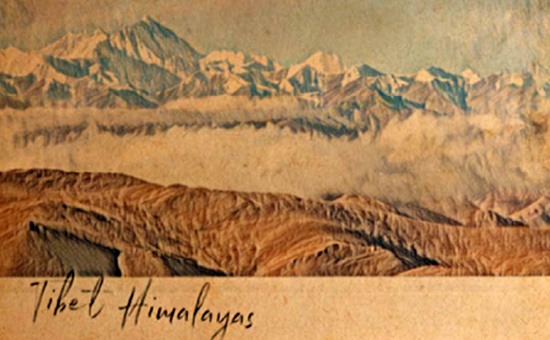
Tibet: Taking
and Giving
Athisa Dipankara Srijnana, most of his
teaching and telling have been lost in the original Sanskrit. But translated
and codified by his Tibetan disciples, they thrive as a living spiritual
practise. What India lost, Tibet preserved. Only to offer it back to the world.
Taking and giving, of another kind.
The story of that journey, perhaps for
another time, when we find ourselves surfing the waves of the timeless. For
now, Atisha’s final testament, ‘dharman alokayamaḥ’, we illuminate the dharmas. When he was asked what it meant, he
answered, it was now time to practise the dharmas. Not just dharmas in words,
but in everyday life, in action.
Author is an award winning documentary filmmaker, cinematographer, writer, speaker and a meditation facilitator. All pictures by author. More on her at www.daminijosh.in
Also read
1. About
Vikramshila Univerity
2. Pictures of
Nalanda University
3. Borubudur
Stupa – 4 levels to truth
4. Kumarjiva
– A Great Buddhist Master
5. Harmonious
blend of Hinduism, Buddhism, Shintoism in Japan